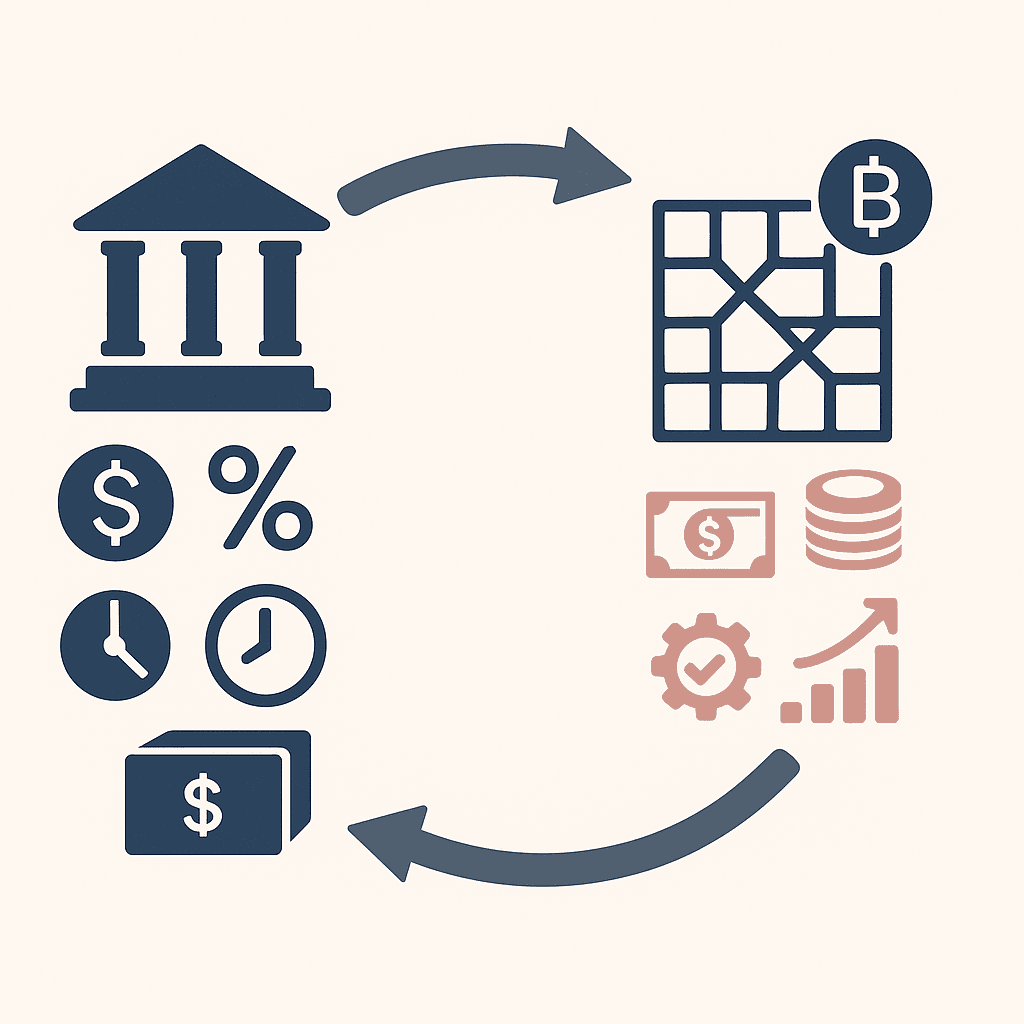When JPMorgan processes over $10 trillion annually through their traditional banking rails while Circle's USDC settles $200+ billion monthly on-chain, it's clear we're witnessing two financial paradigms running in parallel. But which one actually costs less for your business?
The answer isn't as straightforward as crypto evangelists would have you believe. Let me break down the real numbers, including the fees everyone conveniently forgets to mention.
The True Cost of SWIFT Wire Transfers
SWIFT doesn't actually move money, it's a messaging system that tells banks how to move money. Here's what you're really paying for:
Domestic Wire Transfers:
Sending bank fee: $15-30
Receiving bank fee: $10-20
Total: $25-50 per transaction
Settlement time: Same day to 1 business day
International Wire Transfers:
Sending bank fee: $25-50
Intermediary bank fees: $10-25 (often multiple banks)
Receiving bank fee: $10-20
FX spread: 2-4% above interbank rates
Total for a $10,000 transfer: $245-465 (2.45-4.65%)
Settlement time: 1-5 business days
Hidden SWIFT Costs:
Failed payment investigation: $25-50
Amendment fees: $25-40
Compliance delays: Opportunity cost of frozen funds
Weekend/holiday delays: Lost yield on idle capital
Stablecoin Transfer Costs: The Complete Picture
Here's where most crypto content gets misleading—they only show you the on-chain transaction fee and ignore everything else.
On-Chain Transaction Costs:
Ethereum USDC transfer: $5-50 (depending on network congestion)
Solana USDC transfer: $0.0001-0.001
Polygon USDC transfer: $0.01-0.10
The Real Costs Nobody Talks About:
Fiat On-Ramp Fees (Getting money INTO crypto):
Coinbase Pro: 0.5% trading fee + 1.49% ACH fee
Circle Business Account: 0.1-1.0% depending on volume
Wire to exchange: Same SWIFT fees as above
Fiat Off-Ramp Fees (Getting money OUT of crypto):
Exchange trading fees: 0.1-0.5%
Withdrawal fees: $10-25 for wire
Bank receiving fees: $10-20
Complete Stablecoin Transfer Cost for $10,000:
On-ramp: $100-200 (1-2%)
Transaction fee: $0.0001-50 (depends on network)
Off-ramp: $100-200 (1-2%)
Total: $200-450 (2-4.5%)
Where Stablecoins Win Today
1. Speed Advantage
Stablecoin settlement: 15 seconds to 10 minutes
SWIFT settlement: 1-5 business days
Weekend/holiday availability: 24/7 vs. business hours only
2. Transparency
Every transaction is auditable on-chain
No correspondent banking black boxes
Real-time settlement confirmation
3. Volume Economics For businesses doing frequent transfers, the fixed nature of on-chain fees creates economies of scale that SWIFT's percentage-based FX spreads can't match.
Example: Monthly $100,000 in international transfers
SWIFT: 10 transfers × $2,450-4,650 = $24,500-46,500 annually
Stablecoin: One-time setup + (100 × $0.0001) = ~$2,000-4,000 annually
Where SWIFT Still Wins
1. Regulatory Clarity Banks have 150+ years of regulatory frameworks. Stablecoins are still figuring it out.
2. Universal Acceptance Every business bank accepts wire transfers. Most still won't touch crypto.
3. Dispute Resolution Established chargeback and dispute mechanisms vs. "code is law" finality.
4. Accounting Integration Your QuickBooks doesn't have a "USDC yield" category yet.
The Programmability Advantage That Changes Everything
Here's where the comparison breaks down entirely, because we're not just comparing payment rails anymore. We're comparing programmable money vs. static money.
Traditional Banking: Payment as Expense
Wire fee: -$45
FX spread: -$300
Funds sit idle during transit: $0 yield
Net cost: -$345
Programmable Stablecoins: Payment as Revenue Opportunity Take RebelFi's approach: payments automatically flow into yield-generating DeFi protocols.
Transfer fee: -$0.0001
Yield earned during settlement (instant): +$1.50/day at 5.5% APY
Yield earned while funds await use: +$1.50/day ongoing
Net cost: Potentially positive ROI
Smart Payment Features Impossible with SWIFT:
Dynamic Discounting: Invoice discounts based on yield potential
Pull-Based Payments: Recipient claims funds, payer earns yield until collection
Conditional Escrows: Funds released based on smart contract conditions
Yield Splitting: Automatically route interest to different accounts
Real-World Case Study: Coffee Shop Chain
Traditional Setup:
Daily deposits: $5,000
Wire transfer to supplier (weekly): $35,000
Wire fees: $45/week = $2,340/year
Idle funds earning: 0.1% savings account
Stablecoin Setup:
Daily deposits into yield-bearing USDC account: 5.5% APY
Weekly supplier payment via programmable transfer: $0.0001 fee
Annual yield on $35,000 average balance: $1,925
Net improvement: $4,265/year
The Honest Truth About Adoption
Stablecoins are better for payments when:
You're already crypto-native
Volume is high enough to absorb on/off-ramp costs
You can keep funds in stablecoins between transactions
Speed matters more than maximum cost optimization
SWIFT is still better when:
One-off international transfers
Recipients don't accept crypto
Regulatory compliance is paramount
You need dispute resolution mechanisms
What's Coming: The Convergence
The real disruption isn't stablecoins replacing SWIFT—it's programmable money making the comparison irrelevant.
Near-term developments:
Bank-issued stablecoins (JPM Coin, upcoming consortium stablecoin)
SWIFT exploring blockchain settlement
Regulatory clarity via the GENIUS Act
Enterprise stablecoin infrastructure (Stripe's Bridge acquisition)
The endgame: Payment rails that combine SWIFT's regulatory compliance with stablecoin programmability. Your business payments will earn yield by default, settle instantly, and integrate with smart contracts while still working with traditional banking partners.
Making the Switch: A Practical Framework
Start experimenting if:
20%+ of your payments are crypto-to-crypto
You send >$50,000/month internationally
Cash flow timing is critical to your business
You're willing to manage regulatory complexity
Questions to ask your CFO:
What percentage of our wire transfer volume could stay in stablecoins end-to-end?
How much are we paying in FX spreads annually?
What's the opportunity cost of funds sitting in 0.1% checking accounts?
Are our payment processes programmable enough to benefit from smart contracts?
The future of business payments isn't about choosing stablecoins OR traditional banking, it's about using programmable money to make every transaction work harder for your business. The question isn't whether stablecoins will replace SWIFT. It's whether your competitors will start earning yield on their payment flows before you do.
Ready to turn your payment processing from a cost center into a revenue stream? Explore how RebelFi's programmable stablecoin infrastructure can transform your business payments atrebelfi.io



